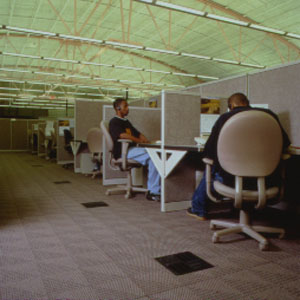
"We wanted to create an environment with a wow factor," notes Daniel, Accor's senior vice president for reservations. "We were looking for something unique and appealing to help us attract and retain good employees in a relatively tight labor market."
Creating a "consistent and uniform HVAC system" was one of Daniel's criteria. A York FlexSys underfloor-air system was selected to meet that challenge, delivering conditioned air to 135 workstations in the 14,000-square foot call center.
According to Daniel, the early-1960s facility provided the shell needed for the call center, with high arched ceilings adding to the center's spaciousness and aesthetic appeal. Light colors, sound masking, indirect lighting and ergonomically-designed workstations are just a few of the architectural elements, while employee amenities include an off-duty "community center" complete with a fountain, cyber cafe and large-screen television.
"This is a 24-hour call center that will have about 300 employees when fully staffed," noted Daniel. "I think we've created a great environment for people to work in. The HVAC system is an important element of that environment."
Kuempel Service/Comfort Systems U.S.A. of Cincinnati, Ohio, was the mechanical contractor on the project working with KSBA Architects of Pittsburgh, Pa., and Flanigan Real Estate Resources, property developers, also of Cincinnati.
Flanigan is known for expertise in the design and construction of high-technology work environments. "We saw this as a perfect application for the raised-floor solution," noted the firm's president, Mike Flanigan. The rest of the design-build team agreed.
According to John Kuempel Jr., PE, sales manager for Comfort Systems, Accor chose raised-floor construction for the call center because of the flexibility it provides in wire management for power, voice and data networks. Tate Access Floors provided the raised-floor and wire systems for the project.
In addition, notes Roger Kingsland, president of KSBA, Accor was attracted to "the quality of the solution in terms of people comfort, air quality, and flexibility." KSBA was an early proponent of underfloor-air systems, according to Kingsland. The firm has incorporated it in buildings for Liberty Mutual in Phoenix, TeleSpectrum in Buffalo, N.Y., and Duquesne Light in Pittsburgh, as well as its own headquarters facility.
"The raised-floor platform answers a lot of the technology needs for wire management," Kuempel said. "That's a natural. Now, the introduction of underfloor air with personal control allows each occupant to customize his or her environment."
In the Accor project, two standard, 25-ton packaged rooftop HVAC units supply conditioned air to the raised-floor area. The air is distributed to the occupied space by 170 York FlexSys underfloor-air terminals. The air terminals can be located anywhere in the raised-floor grid. Then, call center employees can individually adjust air-discharge grilles to any one of 16 different air flow patterns, for highly personalized comfort control.
Kuempel likes the personal control afforded by the underfloor-air system. "It's a highly adjustable air outlet for direct occupant control," says Kuempel. In turn, he thinks this can lead to a higher rate of job satisfaction and employee retention.
The York FlexSys system also provides better overall temperature control than first-generation underfloor-air systems because each terminal has variable-air-volume control. Early underfloor-air products without automatic air volume controls had a poor reputation for comfort. "The new system represents a paradigm shift in personal comfort," Kuempel says.

Building Technology Platform
The concept applied in the Accor call center is called the Building Technology Platform. The concept integrates access flooring - and the voice, data and power networks it can house - with an advanced under floor-air distribution and control system. The result is a highly flexible, "technology-ready" design that speeds building occupancy and reconfiguration, providing maximum comfort and indoor air quality (IAQ). Better IAQ is achieved because conditioned air is delivered where it does the most good - at the floor-level breathing zone, not above people's heads. So, the conditioned air doesn't mix with odors, particles, and pollutants that collect near the ceiling.The FlexSys system also offers first-cost -and life-cycle-cost savings. Because air moves in the plenum between the structural floor and the access floor, conventional ceiling ductwork can be eliminated- This saves first-cost and frees overhead space for other design purposes.
Rearrangement costs are also reduced. Because the entire area under the floor becomes a pressurized air plenum, a FlexSys terminal can be installed literally anywhere in the raised-floor grid. To shift workstations, maintenance personnel simply move one of the air terminals, bringing HVAC to the new location. (if necessary, the voice, data and power cabling can also be moved easily). This can be done much quicker, and at less expense, than with traditional building systems.
Kingsland notes KSBA applies a "performance design approach" in which the firm evaluates the return on investment of various design solutions. They evaluate five main criteria - capital cost, energy cost, healthcare cost, productivity improvements and tax impact. He believes the Building Technology Platform with underfloor air rates very well in all these areas.
Kingsland summarizes it this way: On capital cost, savings in cabling and HVAC components (including ductwork) offset the cost of the raised floor. Energy savings accrue from longer periods of "free cooling." Healthcare costs can be reduced by cleaner air. Productivity improvements are a "hands down" winner, considering the ease in changing the FlexSys system. And tax savings can be achieved through an accelerated depreciation schedule, because much of the Building Technology Platform can be considered equipment rather than part of the building.
For more information, go to www.york.com.
Publication date: 02/19/2001

Report Abusive Comment